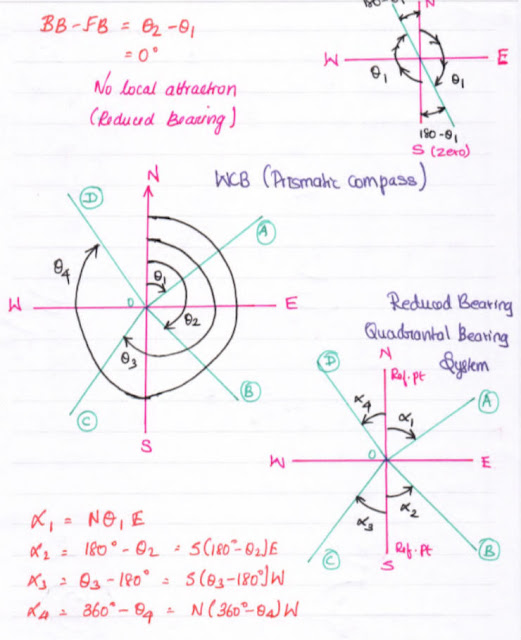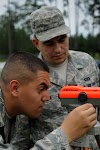Compass Surveying
- Compass Surveying is a type of angular surveying where the magnetic bearing of the survey lines is measured either from the north or from the south or from both.
- A Compass is used to measure bearing only. i.e., the direction of a survey line from north or south along with reading but it cannot be used to measure the angle of survey lines.
- The angle between two survey lines is the difference between their bearings which cannot be obtained directly either from a prismatic compass or from a surveyor compass. The angle between two survey lines can be measured directly with the help of Theodolite and Box sextant.
- In prismatic compass, the zero degree is at South End and 90° at West, 180° at North, 270° at East, 360° at South (Clockwise direction).
- In surveyor compass, 0° is always at North & South. 90° is always at East & West. Where the reading is Clockwise or Anti-clockwise direction.
There are three systems of angular measurement:-
1) Sexagesimal System:-
1 circumference = 360° of arc
1° = 60' minutes of arc
1' = 60" seconds of arc
It is used in the UK, USA, INDIA
2) Centesimal System:-
1 circumference = 400 grads
1 grads = 100 centigrade
1 centigrade = 100 centi centigrade
It is used in EUROPEAN countries.
3) Hours System:-
1 circumference = 24 hours
1 hour = 60 minutes of time
1 minute = 60 minutes of time
It is mainly used for navigation purposes and astronomical survey.
- The magnetic needle becomes parallel at Equatorial axis ( parallel to the earth surface ) where the magnetic lines of forces of the earth are parallel and hence the dip is zero. But at the north pole, the magnetic north dips down and hence dip is 90° at North pole of the earth. Similarly, the magnetic south end of the needle dips down at the south pole of the earth and hence dip is 90° at poles. Dip is the vertical angle made by the magnetic needle with the earth surface. The earth is a powerful magnet where magnetic lines of forces originate at the south pole and terminate at the north pole. But at the equator, they are parallel to the earth surface. The line joining the points of equal dip is known as Isoclinic lines.
- The projection of the magnetic lines of forces of the earth on a horizontal plane is known as True Meridian which is a standard reference line to determine true bearings of survey lines. i.e., the horizontal angle between true meridian and a survey line is known as True Bearing ( Azimuth).
- The line passing through a magnetic needle ( freely suspended needle ), is known as Magnetic Meridian which is not a standard reference line due to possibilities of local attraction. But in practice, every survey line is measured from Magnetic Meridian only. The angle between magnetic meridian and a survey line is known as Magnetic Bearing which is also known as simply Bearing.
- The horizontal angle between true meridian and magnetic meridian is known as Declination or Variation. If the magnetic meridian is towards the east of a true meridian ( Magnetic north is towards the east of true north ) then the horizontal angle is called eastern declination. But if the magnetic north is towards the west of true north then the horizontal angle is called Western declination. The line joining points of equal declination are known as Isogonic line. The line joining points of zero declination are called as Agonic line. i.e., Magnetic north exactly coincides with the true north.
 |
| Compass Surveying |
 |
| Compass Surveying |
 |
| Compass Surveying |
Difference Between Prismatic Compass And Surveyor Compass:-
| S.No | Prismatic Compass | Surveyor Compass |
|---|---|---|
| 1 | The magnetic needle is of bar needle. | The magnetic needle is of edge type |
| 2 | The needle does not act like the index. | The needle acts as the index. |
| 3 | The needle is attached with the graduated circular coordinates | The needle is not attached with the graduated coordinates. i.e., it is free |
| 4 | The circular graduated coordinates is not attached to the box. i.e., it is free | The graduated coordinates are attached to the box. |
| 5 | The graduated coordinates don't rotate along with the line of sight. | The graduated coordinates rotate along with the line of sight. |
| 6 | The reading is engraved inverted. | The readings are engraved erect. |
| 7 | The system of graduation of reading is in WCB in a clockwise direction | The system of graduation is in reduced bearing or Quadrantal Bearing either in clockwise or in anti-clockwise. |
| 8 | The graduation starts 0° at South and 180° at North, 90° at West, 270° at East, 360° at South. |
The graduation starts at 0° at North & South and 90° at East & West. |
| 9 | The object vane consists of a wide opening vane with a vertical hair. | The object vane consists of a wide opening vane with a vertical hair. |
| 10 | The eye vane consists of a narrow slit where a prism is provided. | The eye vane consists of narrow slit without prism. |
| 11 | Sighting and observing the readings can be done simultaneously with the help of prism kept at eye vane. | Sighting and observing readings cannot be done simultaneously. i.e., Readings can be observed by looking at the top. |
| 12 | A tripod stand may or may not be used. | The tripod stand is compulsorily required. |
Types of Declination:
1) The horizontal angle between the true meridian and the magnetic meridian is called Declination (Variation).2) There are following types of variation in declination
a) Diurnal Variation:-
- It takes place in 24 hrs duration called daily variation which is about 10 min (10')
- Diurnal Variation is the highest at the poles and lowers at the Equator.
- It is higher during day time and lowers during the night.
- It is higher during the summer season and lowers during the winter season.
b) Annual Variation:-
- It occurs during 1-year duration having a value of about 10 min (10').
c) Secular Variation:-
- It occurs during 100 to 200 years of observation.
- It is similar to swinging of a pendulum.
- The variation is about 10° in the East or West.
d) Irregular Variation:-
- It occurs due to magnetic storm, earthquake, severe storm.
Note:- The maximum permissible error in compass survey is 15√N min
where N = Number of compass station (or) Number of survey lines (or) Number of sides of a closed traverse.
Local attraction:-
i) It is a phenomenon due to which the magnetic needle of a compass gets affected due to the presence of magnetic substance like Chain, Metallic tape, Electric line, Railway line, Iron ore.
ii) To detect local attraction at the site, the fore bearing and back bearing must be measured and their difference shall be obtained. If (fore bearing - back bearing) = 180° in WCB system then there is no local attraction but if (fore bearing - back bearing) ǂ 180° in WCB system then local attraction takes place which is to be corrected from a station where there is no local attraction.
In the case of RB system, if FB - BB = 0° (but opposite direction) then there is no local attraction.
iii) If error due to the local attraction is positive then a correction must be negative of the same magnitude.
iv) The correction for declination shall be applied after correction for local attraction.





0 Comments